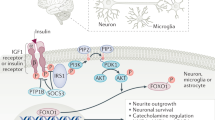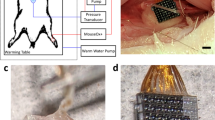Abstract
Body adiposity is normally maintained within rigid limits1–3. Although it is not clear that this regulation fits a strict negative feedback pattern, animals do maintain a relatively constant body adiposity4. It has been postulated that this regulation is mediated by some signal which informs centres controlling food intake, probably located in the brain, as to the present state of adiposity5,6. The identity of the signal is unknown, but the direct correlation between body adiposity and basal insulin levels in the plasma7–9, suggests insulin as a possible candidate. This hormone is present in the cerebrospinal fluid (CSF) of many species10–13, and is a slow integral over time of the level within the plasma14. Thus, the level of insulin in the CSF is relatively resistant to short-term plasma fluctuations of insulin. Obese humans have higher levels of CSF insulin than lean controls and the CSF insulin level of both obese and lean humans is reduced proportionately after a prolonged fast15. We have therefore postulated16 that the feedback system responding to body adiposity uses the concentration of insulin in the CSF as a major signal. Additional support for such a role is found in recent reports that insulin receptors are present in several regions of the brain and spinal cord17–20. We now present additional evidence for our hypothesis by showing that in baboons the infusion of exogenous insulin into the CSF elicits a reliable and predictable decrease in food intake and body weight.
This is a preview of subscription content, access via your institution
Access options
Subscribe to this journal
Receive 51 print issues and online access
$199.00 per year
only $3.90 per issue
Buy this article
- Purchase on Springer Link
- Instant access to full article PDF
Prices may be subject to local taxes which are calculated during checkout
Similar content being viewed by others
References
Bray, G.A. The Obese Patient Saunders, Philadelphia (1976).
Woods, S. C., Decke, E. & Vasselli, J. R. Psychol. Rev. 81, 26–43 (1974).
Assimacopoulos-Jeannet, F. & Jeanrenaud, B. Clin. Endocr. Metab. 5, 337–372 (1976).
Mrosovsky, N. & Powley, T. L. Behav. Biol. 20, 205–223 (1977).
Kennedy, G. C. Proc. R. Soc. B 140, 578–592 (1953).
Hoebel, G. B. A. Rev. Physiol. 33, 533–568 (1971).
Bagdade, J. D., Bierman, E. L. & Porte, D. Jr J. clin. Invest. 46, 1549–1557 (1967).
Grant, D. B. Archs Dis. Childh. 42, 375–378 (1967).
Stephan, F. et al. Diabetologia 8, 196–201 (1972).
Margolis, R. U. & Altszuler, N. Nature 215, 1375 (1967).
Anderson, D. K. & Hazelwood, R. C. J. Physiol., Lond. 202, 83–95 (1969).
Woods, S. C. & Porte, D. Jr Diabetes 24, 905–909 (1975).
Hill, D. E. et al. Clin. Res. 26, 71A (1978).
Woods, S. C. & Porte, D. Jr Am. J. Physiol. 233, E331–E334 (1977).
Owen, O. E. et al. Diabetes 19, 397 (1970); Metabolism 23, 7 (1974).
Woods, S. C. & Porte, D. Jr in Hunger: Basic Mechanisms and Clinical Implications (eds Novin, D. et al.)273–280 (Raven, New York, 1976); Adv. metab. Dis. 9, 283–312 (1978).
Havrankova, J., Brownstein, M. & Roth, J. Nature 272, 827–829 (1978).
Havrankova, J., Schmehel, D., Roth, J. & Browstein, M. Proc. natn. Acad. Sci. U.S.A. 75, 5737–5741 (1978).
Pacold, S. T., Small, E. & Blackard, W. C. Clin. Res. 26, 34A (1978).
Van Houten, M. et al. Clin. Res. 26, 533A (1978).
Myers, R. D. Methods in Psychobiology Vol. 1 (Academic, New York, 1971).
Woods, S. C. et al. J. Neurosci. Meth. (in the press).
Riche, D. Atlas Stereotaxique du Cerveau de Babouin (Centre National de la Recherche Scientifique, Paris, 1968).
Hays, W. L. Statistics for Psychologists, 637 (Holt, Rinehart and Winston, New York, 1963).
Porte, D. Jr et al. J. clin. Invest. 45, 228–236 (1966).
Balagura, S. J. comp. Physiol. Psychol. 65, 30–32 (1968).
Martin, J. R. & Novin, D. Physiol. Behav. 19, 461–467 (1977).
Woods, S. C. & Porte, D. Jr Physiol. Rev. 54, 596–619 (1974).
Porte, D. Jr et al. Pharmac. Biochem. Behav. 3, 127–133 (1975).
Author information
Authors and Affiliations
Rights and permissions
About this article
Cite this article
Woods, S., Lotter, E., McKay, L. et al. Chronic intracerebroventricular infusion of insulin reduces food intake and body weight of baboons. Nature 282, 503–505 (1979). https://doi.org/10.1038/282503a0
Received:
Accepted:
Published:
Issue Date:
DOI: https://doi.org/10.1038/282503a0
This article is cited by
-
The insulin resistant brain: impact on whole-body metabolism and body fat distribution
Diabetologia (2024)
-
Daniel Porte Jr, 13 August 1931–13 May 2023
Diabetologia (2023)
-
Interaction of MC4R rs17782313 variants and dietary carbohydrate quantity and quality on basal metabolic rate and general and central obesity in overweight/obese women: a cross-sectional study
BMC Endocrine Disorders (2022)
-
Prohormone convertase 1/3 deficiency causes obesity due to impaired proinsulin processing
Nature Communications (2022)
-
The effect of intranasal insulin on appetite and mood in women with and without obesity: an experimental medicine study
International Journal of Obesity (2022)
Comments
By submitting a comment you agree to abide by our Terms and Community Guidelines. If you find something abusive or that does not comply with our terms or guidelines please flag it as inappropriate.



